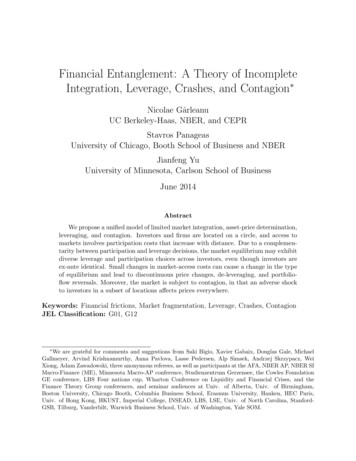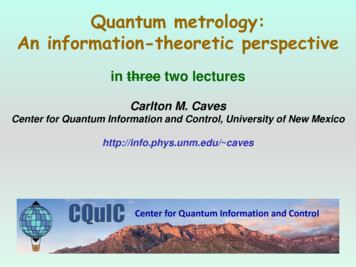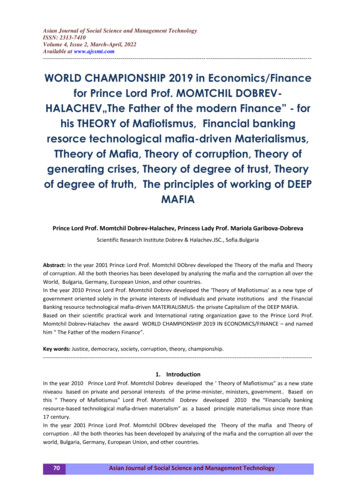
Transcription
Financial Entanglement: A Theory of IncompleteIntegration, Leverage, Crashes, and Contagion Nicolae GârleanuUC Berkeley-Haas, NBER, and CEPRStavros PanageasUniversity of Chicago, Booth School of Business and NBERJianfeng YuUniversity of Minnesota, Carlson School of BusinessJune 2014AbstractWe propose a unified model of limited market integration, asset-price determination,leveraging, and contagion. Investors and firms are located on a circle, and access tomarkets involves participation costs that increase with distance. Due to a complementarity between participation and leverage decisions, the market equilibrium may exhibitdiverse leverage and participation choices across investors, even though investors areex-ante identical. Small changes in market-access costs can cause a change in the typeof equilibrium and lead to discontinuous price changes, de-leveraging, and portfolioflow reversals. Moreover, the market is subject to contagion, in that an adverse shockto investors in a subset of locations affects prices everywhere.Keywords: Financial frictions, Market fragmentation, Leverage, Crashes, ContagionJEL Classification: G01, G12 We are grateful for comments and suggestions from Saki Bigio, Xavier Gabaix, Douglas Gale, MichaelGallmeyer, Arvind Krishnamurthy, Anna Pavlova, Lasse Pedersen, Alp Simsek, Andrzej Skrzypacz, WeiXiong, Adam Zawadowski, three anonymous referees, as well as participants at the AFA, NBER AP, NBER SIMacro-Finance (ME), Minnesota Macro-AP conference, Studienzentrum Gerzensee, the Cowles FoundationGE conference, LBS Four nations cup, Wharton Conference on Liquidity and Financial Crises, and theFinance Theory Group conferences, and seminar audiences at Univ. of Alberta, Univ. of Birmingham,Boston University, Chicago Booth, Columbia Business School, Erasmus University, Hanken, HEC Paris,Univ. of Hong Kong, HKUST, Imperial College, INSEAD, LBS, LSE, Univ. of North Carolina, StanfordGSB, Tilburg, Vanderbilt, Warwick Business School, Univ. of Washington, Yale SOM.
1IntroductionThere is a substantial body of empirical literature (described in detail in the next section)concluding that market integration is limited and risk sharing is imperfect. In particular,a) capital tends to stay “close” to its origin, b) reward for risk reflects — at least partially— “local” factors that one would expect to be diversifiable, and c) reductions in capitalflows and the extent of market integration tend to coincide with substantial increases in riskpremia and leverage reductions.Motivated by these findings, we propose a tractable theoretical framework that offersa unified view of asset-price determination, endogenous market fragmentation, contagionacross seemingly unrelated markets, diversity of observed investment strategies, and deleveraging.The model features a continuum of investors and financial markets located on a circle.Investors are endowed with shares of a risky firm domiciled at their location and traded atthe same location. The dividends of this security are closely correlated with dividends ofsecurities located in nearby locations and less correlated with securities in distant locations.Even though securities in more distant locations offer greater benefits from the perspective ofdiversification and risk allocation, participation in such markets involves costs that grow withthe distance from the current location. Such costs are reflective of the fact that informationalfrictions are likely to grow as investors participate in progressively more unfamiliar markets.Indeed, inside our model distance on the circle should not be viewed narrowly as geographicaldistance. For our purposes, distance is a broad measure parametrizing a tradeoff betweenthe cost of overcoming frictions in accessing various asset classes and the diversificationbenefits offered by these asset classes. Alongside the risky markets, investors have access toa zero-net-supply bond market.Because access to financial markets is subject to frictions, the market equilibrium featureslimited integration. Investors from nearby locations, who face similar cost structures, chooseto participate on arcs of the circle that feature a high degree of overlap. Even though theremay be many assets with no common investor, this overlap renders all markets (indirectly)“entangled.”1
In such a framework, we examine four sets of issues: a) the determination of asset pricesin light of limited market integration; b) the structure of optimal investment strategies, i.e.,arcs of participation, leverage, and risky-asset positions chosen by investors; c) the effect ofchanges to the financial technology (i.e., the magnitude of market-access costs); and d) thepropagation of “local” shocks to the financial technology. We summarize our findings abouteach of the four issues in turn.a) Limited market integration implies that investors are over-exposed to the risks oflocations in their vicinity. Consequently, risk premia are higher than they would be in africtionless world. An important aspect of the analysis is that the magnitudes of risk premiaand of portfolio flows are tightly linked and reflect the extent of market integration.b) Although investors in any given location are identical in every respect, their investmentstrategies may be diverse with some investors choosing high-leverage strategies and increasedextent of participation in risky markets, and others choosing unleveraged, low-participationstrategies.The intuition for this finding is that leverage and participation decisions are complements.For a given level of risk premia, participating in more markets increases the maximum Sharperatio attainable, which induces investors to take more leverage. Since leverage increasesthe overall variance of the portfolio, it increases the marginal benefit of further marketparticipation and diversification. This complementarity between participation and leveragedecisions makes the problem of choosing the optimal participation arc a non-concave problemwith (possibly) multiple local optima. As is commonly the case in situations where investorsmaximize non-concave problems, a symmetric equilibrium (whereby all investors adopt thesame policies) may fail to exist, and the only equilibrium is asymmetric. It is noteworthythat the non-concavities arise even when the participation costs are convex.This implication of the model is consistent with the diversity of investment strategiesoffered to investors by, say, mutual funds and hedge funds. More importantly, it shows thatportfolio leverage may arise endogenously in fragmented markets, without requiring inherentdifferences between investors.c) An illustration of the consequences of the complementarity between the breadth ofparticipation and leverage is provided by the introduction of borrowing limits, e.g., via2
margin constraints.1 In such a situation, different types of equilibria may coexist, generatingfragility. For instance, marginal variations in participation costs may cause the type ofequilibrium to change, causing discontinuous reactions in prices, capital flows, and leverage.The intuition is as follows. Absent leverage constraints, broad-participation decisionsby different investors are substitutes: The less other investors participate, the lower theprices of risky assets, and thus the higher an individual investor’s incentive to take leverageand participate broadly in markets. A binding leverage constraint changes the situationsignificantly. In this case, the lower risky-asset prices necessitate a lower leverage, i.e., areduction in the extent to which one can take advantage of an access to diversified portfolios.The consequence is that the incentive to participate broadly is diminished, relative to theno-constraint case, by other investors’ non-participation. This complementarity may be sostrong that multiple equilibria, featuring distinct prices, extents of integration, and aggregateleverage, can co-exist: If prices are low, then leverage is constrained to be low and there isn’tenough incentive to participate broadly, justifying low prices. If prices are high, then agentscan leverage sufficiently to justify paying for broad participation, which supports high prices.d) The fact that markets are only partially integrated may strengthen the interdependenceof the prices of risky securities in different locations. We present an example where thefinancial technology “breaks down” (i.e., the participation costs rise to infinity) only in asubset of locations — we refer to them as the “affected” locations. We show that such anevent pushes prices in almost all locations downward. This is true even for locations thatare not connected with the affected locations through asset trade and also have negativedividend correlation with them.The intuition for this finding is as follows. As a direct effect of the shock in the affectedregions, investors in affected locations stop investing in risky markets in their vicinity. Consequently, prices in these locations fall so as to attract demand from neighboring unaffectedlocations. The portfolio reallocation in these neighboring locations happens away from other,farther locations, resulting in weaker demand in these farther locations, necessitating pricedrops in these locations as well, so as to attract demand from locations neighboring theneighboring locations, etc.1In Appendix D we consider alternative formulations of borrowing frictions, motivated by limited liability.3
The extent of price drops required to compensate investors for tilting their portfolios toabsorb local risks depends on the extent of their overall participation in risky markets. Ifthe extent of their participation is small, so that their portfolio is heavily exposed to risksin their vicinity, then a tilt towards a nearby location requires a higher compensation. Bycontrast, if investors’ portfolios are invested across a broad range of locations, then they aremore willing to absorb risks in their vicinity. Hence, somewhat surprisingly, the higher thedegree of market integration, the lower the price drop in response to a local participationshock (and vice-versa).2In summary, the paper offers a unified framework to study several financial-market phenomena as a result of (endogenous) market segmentation. Besides the specific applicationsthat we consider, which are meant to illustrate the structure of our framework, we believe that the paper also makes a technical contribution; it provides a particularly tractableframework to study the numerous instances in economics where frictions prevent optimalrisk diversification and capital allocation across asset classes.Our work is related to several strands of theoretical and empirical literature. We discussconnections to the theoretical literature here and postpone a discussion of related empiricalliterature for the next section.Through its focus on incomplete participation by all agents, our paper is related to theseminal contribution of Merton (1987) and the studies inspired by it. We endogenize thedegree of participation, and choose a specific asset-universe structure. Circular structureshave been repeatedly used in a variety of applications from location models in industrialorganization (Salop (1979)) to the literature on financial networks.3 From a technical perspective, our paper proposes a novel and quite tractable structure to model risky payoffscontinuously distributed on a circle. The paper also differs from the financial-network literature in setup and questions addressed. Specifically, we study a relatively standard Walrasianexchange economy with (endogenously) limited participation, while that literature typically2Interestingly, albeit in a completely different setting, Allen and Gale (2000) also finds that contagion ismore severe when financial interconnectivity — between deposit-taking institutions, in that model — is low.3An indicative and incomplete listing of papers studying networks, and in particular circular ones, infinance includes Allen and Gale (2000), Freixas et al. (2000), Allen et al. (2012), Caballero and Simsek(2012), Acemoglu et al. (2013), and Zawadowski (2013). Allen and Babus (2009) offers a survey of theliterature.4
concentrates on banking issues, network externalities, etc.Allen and Gale (2004a,b) and Carletti and Leonello (2012) provide examples of mixedequilibria whereby banks — faced with the possibility of runs — may choose different strategies anticipating trading (of loans) with each other at a subsequent date. The source ofasymmetric equilibria in our paper is different, and more closely related to Aumann (1966),whose analysis covers Walrasian setups (without idiosyncratic liquidity shocks) with nonconcave investor-optimization problems.There exists a vast literature analyzing the interaction between declining prices and tightening collateral constraints — we do not attempt to summarize this literature and simplyrefer to Kiyotaki and Moore (1997) for a seminal contribution. That literature commonlyassumes an exogenous motivation for trading (e.g., differences in productivity, beliefs, or riskaversion); the role of the leverage constraint is to amplify the effect of exogenous shocks,by limiting the set of feasible trades between heterogeneous agents. In our setup, marketparticipants are ex-ante identical, with heterogeneous strategies arising endogenously. Asa result, an investor’s ability to leverage determines whether an asymmetric equilibriumcan arise in the first place: The constraint doesn’t only impact the set of feasible trades,but also affects the investors’ incentive to pay the costs required for broad-participation,high-Sharpe-ratio strategies. This additional feedback effect can be very strong, renderingparticipation decisions complements rather than substitutes and leading to multiple equilibria, thus fragility.4,5Finally, the domino effect produced by our model relates it to the vast literature oncontagion. We do not attempt to summarize this literature. Instead, we single out as anatural counterpoint a particular mechanism proposed in many models as an explanation of4Krishnamurthy (2010) discusses two important aspects of a financial crisis: balance-sheet effects andthe disengagement of investors from markets (specifically, due to an increase in Knightian uncertainty).Balance-sheet effects and declines in participation are also present in our framework, where the feasibilityand the attractiveness of alternative leverage-participation combinations are jointly determined.5The discontinuous dependence of the price on underlying parameters relates our paper to the literaturemodeling abrupt price changes (“crashes”) through changes in the type of equilibrium. These papers typicallyfeature backward-bending demand curves that generate multiple equilibria (see, e.g., Gennotte and Leland(1990), Barlevy and Veronesi (2003), Yuan (2005), Brunnermeier and Pedersen (2009), and Garcia and Strobl(2011)). The mechanism responsible for multiple equilibria in our paper is different, though, since it relieson the complementarity between participation and leverage.5
contagion. Specifically, many papers6 posit the existence of some agents, frequently of limitedrisk-bearing capacity, who price all the assets and whose marginal utility therefore transmitsshocks from one asset to the price of another. In contrast, contagion in our model obtainseven though no agent participates in all markets. A shock in one area is transmitted to adistant one by affecting first the immediately neighboring areas, which in turn affect theirneighboring areas, etc. A practical implication is that there can be positive interdependencebetween the prices in locations by negatively correlated dividends and no common traders.7The paper is organized as follows. Section 2 presents in greater detail the empirical evidence underlying and motivating this paper. Section 3 presents the baseline model. Section4 presents the solution and the results. Sections 5 and 6 study crashes, respectively contagion. Finally, extensions, proofs and further discussion on some of the model assumptionsare contained in the Appendix.2Motivating FactsAs a motivation for the assumptions of the model, we summarize some well-documentedfacts concerning the allocation of capital. Table 1 summarizes the evidence on so-called“gravity” equations in international finance. These gravity equations typically specify a loglinear relation between bilateral flows in various forms of asset trade (equities, bonds, foreigndirect investment, etc.) and the sizes of the countries and the geographical distance betweenthem.A striking and robust finding of this literature is that bilateral capital flows and stocksdecay substantially with geographical distance. This finding is surprising, since countriesthat are geographically distant would seem to offer greater diversification benefits; henceone would expect distance to have the opposite sign from the one found in regressions.The literature typically interprets this surprising finding as evidentiary of informationalasymmetries that increase with geographical distance — a crude proxy for familiarity and6See, e.g., Kyle and Xiong (2001), Cochrane et al. (2008), or Pavlova and Rigobon (2008).The fact that contagion between two markets can arise even if there are no common traders and even if theunderlying dividends have no correlation makes our explanation of contagion also distinct from rebalancingapproaches, such as Kodres and Pritsker (2002).76
Table 1: Gravity Equations in International Trade and Finance.The table reports a survey of the literature on gravity equations in international trade and finance. Portesand Rey (2005) uses bilateral equity flow data among 14 countries from 1989 to 1996. Buch (2005) uses thestock of assets and liabilities of banks from 1983 to 1999. Head and Ries (2008) uses bilateral FDI stocks with30 OECD reporters and 32 partners in year 2001. Talamo (2007) uses FDI flow data from 1980-2001. Aviatand Coeurdacier (2007) uses bilateral trade data and bank asset holding data in year 2001. Ahrend andSchwellnus (2012) uses IMF’s Consolidated Portfolio Investment Survey (CPIS) in 2005-2006, which reportsbilateral debt investment for 74 reporting countries and 231 partner countries. Typically, the regressionperformed islog(Xi,j ) α β1 log(GDPi ) β2 log(GDPj ) β3 log(Distancei,j ) controls i,jwhere Xi,j is the equity flow, portfolio holding, FDI flow, FDI stock, trade, or bank asset holdings.SourceDependent variablePortes and Rey (2005)Equity flowsBuch (2005)Bank asset holdingsTalamo (2007)FDI flowHead and Ries (2008)FDI stockAviat and Coeurdacier (2007) TradeAviat and Coeurdacier (2007) Bank asset holdingsAhrend and Schwellnus (2012) Bond holdingsDistancet-stat-0.881 -28.419-0.650 -12.020-0.643 -9.319-1.250 -17.361-0.750 -10.000-0.756 -8.043-0.513 -4.886similarity in social, political, legal, cultural, and economic structures. Supportive of thisinterpretation is the literature that finds a similar relation between distance and portfolioallocations in domestic portfolio allocations.8Further supportive evidence is provided by literature that documents how partial marketintegration affects the pricing of securities. Bekaert and Harvey (1995) finds that localfactors affect the pricing of securities and are not driven out by global factors. An importantadditional finding of Bekaert and Harvey (1995) is that the relative importance of global andlocal factors is time varying, suggesting time-varying integration between markets.Indeed, crisis periods offer an opportunity to visualize the extent of variation in market8For instance, Coval and Moskowitz (1999) shows that US mutual fund managers tend to overweightlocally headquartered firms. Coval and Moskowitz (2001) shows that mutual fund managers earn higherabnormal returns in nearby investments, suggesting an informational advantage of local investors. UsingFinnish data, Grinblatt and Keloharju (2001) shows that investors are more likely to hold and trade thestocks of Finnish firms that are located close to the investors. Similar evidence is presented in Chan et al.(2005): Using mutual fund data from 26 countries, and using distance as a proxy for familiarity, this paperfinds that a version of the gravity equation holds for mutual fund holdings. That is, the bias against foreignstocks is stronger when the foreign country is more distant. In a similar vein, Huberman (2001) documentsfamiliarity-related biases in portfolio holdings.7
BIS reporting banks claims by recipient country: local versus cross border, 2008Q1Ò009Q4100Capital and Bank Flows as Percentage of GDPCumulative percentage change in cross border claims20Gross capital inflowGross capital outflowBIS bank gross inflowBIS bank gross outflow151050 5 10 15 20198019851990199520002005806040200 20 40 60 80 100 1002010 80 60 40 200204060Cumulative percentage change in local claims80100Figure 1: Reversals in global capital flows. Source: Hoggarth et al. (2010). The left plot depictsthe sum of global net purchases of foreign assets by residents (labeled “Gross capital inflows”) andthe sum of global net purchases of domestic assets by foreigners (labeled “Gross capital outflows”).The figure also reports cross-border bank inflows and outflows based on BIS data. Right plot:Cumulative percentage in local claims held by banks against cumulative percentage change incross-border claims during the 2008Q1 - 2009Q4 period. Source: Hoggarth et al. (2010). based onBIS Data on the 50 largest debtor countries by foreign liabilities. For a detailed description of thesample of reporting countries, see Hoggarth et al. (2010).integration. The left plot of Figure 1 reports the sum of global net purchases of foreignassets by residents (labeled “Gross capital inflows”) and the sum of global net purchasesof domestic assets by foreigners (labeled “Gross capital outflows”). The figure also reportscross-border bank inflows and outflows based on BIS data. The picture helps visualize that,in the years preceding the financial crisis of 2008, there was a large increase in gross capitalflows. This expansion in capital flows came to a sudden stop in the first quarter of 2008,as the financial crisis took hold. In line with the patterns illustrated in the left plot ofthe figure, Ahrend and Schwellnus (2012) documents a significantly stronger coefficient ondistance in cross-border gravity equations during 2008-2009. This evidence suggests thatcapital becomes more concentrated “locally” during times of crisis.The right plot of Figure 1 provides a further illustration of capital concentration duringthe crisis by focusing on readily available BIS data. It depicts the cumulative percentagechange in banks’ cross-border claims against the respective cumulative change in their local claims for various countries between 2008Q1 - 2009Q4. Most points on the graph arebelow the 45-degree line, suggesting that the liquidation of the foreign holdings of banks8
was disproportionately larger than the respective liquidation of their local holdings. Directevidence of a “flight to home” effect is provided by Giannetti and Laeven (2012), whichshows that the home bias of lenders’ loan origination increases by approximately 20% if thebank’s home country experiences a banking crisis. Giannetti and Laeven (2012) also arguesthat this flight to home effect is distinct from flight to quality, since borrowers of differentquality are equally affected.We note in passing that the increased portfolio concentration during times of crisis is notlimited to international data. For instance, the collapse of the (non-agency) securitizationmarket during the financial crisis implied increased limitations to the ability of local issuersto diversify local real-estate risk.In summary, the empirical evidence supports the following broad conclusions: a) Capitalstays “close” to its origin, which implies a “local” concentration of risk in investors’ portfolios.b) The extent of market integration is time-varying. Furthermore crises are times whenfinancial integration diminishes quite abruptly.33.1ModelInvestors and firmsTime is discrete and there are two dates, t 0 and t 1. All trading takes place attime t 0, while at t 1 all payments are made and contracts are settled. Investors areprice takers, located at different points on a circle with circumference normalized to one.We index these locations by i [0, 1). Investors have exponential utilities and maximizeexpected utility of time-1 wealth E [U (W1,i )] E e γW1,i ,(1)where W1,i is the time-1 wealth of an investor in location i. The assumptions that investorsonly care about terminal wealth and have exponential utility are made for tractability andin order to expedite the presentation of the results. In Appendix A.1 we extend the model9
to allow for consumption over an infinite horizon.Besides having identical preferences, investors at any given location are also identicalin terms of their endowments and their information sets. Specifically, at time t 0 theinvestors in location i are equally endowed with the total supply of shares (normalized toone) of a competitive, representative firm, which is domiciled at the same location i. Eachfirm pays a stochastic dividend equal to Di in period 1.We specify the joint distribution of the dividends Di for i [0, 1) so as to obtain severalproperties. Specifically, we wish that 1) firms be ex-ante symmetric, that is, the marginalR1distribution of Di be independent of i; 2) the total dividends paid 0 Di di be constant(normalized to one); 3) firms with indices close to each other (in terms of their shortestdistance on the circle) experience a higher dividend correlation than firms farther apart; and4) dividends at different locations be normally distributed.To formalize these notions, we let Zi denote a standard Brownian motion for i [0, 1],and we also introduce the quantityBi Zi iZ1 for i [0, 1] ,(2)known as a Brownian bridge. Two immediate implications of the construction (2) are thatthe Brownian bridge satisfies B0 B1 0 and has continuous paths (a.s.).9Using thedefinition of Bi , we let Di be defined as ZDi 1 σ Bi 1 Bj dj ,(3)0where σ 0 is a constant controlling the volatility of the dividend process. Since thespecification (3) plays a central role in our analysis, we first derive the statistical propertiesof Di , and then we provide a graphical illustration.Lemma 1 Di satisfies the following properties.1. (Symmetry and univariate normality) The marginal distribution of Di is the same for9Equivalently, a Brownian bridge Bt on [0, 1] is a process distributed as the Brownian motion Zt conditional on Z1 0.10
"#")*! #," %('" %&'"!" %'"Figure 2: The left plot depicts a circle with circumference 1. The bold arc on the right plotdepicts the notion of the shortest distance on the circle d(i, j) between points i and j that we usethroughout.all i. Specifically, Di is normally distributed with mean 1 and variance2. (No aggregate risk)R10σ2.12Di di 1.3. (Continuity on the circle) Let d (i, j) min( i j , 1 i j ) denote a metric on theinterval [0, 1). Then Di is continuous (a.s.) on [0, 1) if the interval [0, 1) is endowedwith the metric d.4. (Joint normality and distance-dependent covariance structure) For any vector of locations i (i1 , i2 , . . . , iN ) in [0, 1), the dividends (Di1 , . . . , DiN ) are joint normal, withcovariances given bycov (Din , Dik ) σ2 1d (in , ik ) (1 d (in , ik )) 122 .(4)It is easiest to understand the properties of Di by using a graphical illustration. The leftplot of Figure 2 provides an illustration of the interval [0, 1) “wrapped” around as a circlewith circumference one. The metric d (i, j) can be thought of as the length of the shortestarc connecting i and j, as the right plot of Figure 2 illustrates. Figure 3 illustrates a pathof Zi and the associated paths of Bi and Di .A remarkable property of the dividend structure (3) is that the covariance, and therefore correlation, of dividends in any locations i and j depend exclusively on the distance11
Brownian Motion Z(i)Brownian Bridge B(i)21.51.5110.50.500 0.500.20.40.60.8 0.5100.20.40.6iiD(i) when σ 1D(i) (polar coordinates)0.81221.51100.20.50000.20.40.60.8 0.21 0.2 0.100.10.2iFigure 3: An illustration of the construction of the dividend process Di . The two plots at the topdepict a sample Brownian path Zi , and the associated path of a Brownian bridge Bi . The twobottom plots depict the associated sample path of Di , when the indices i [0, 1) are aligned on aline and when the same interval is depicted as a circle with circumference one.d (i, j) between the two locations, but not the locations themselves. Equation (4) gives anexplicit expression for the covariance of the dividends at different locations. The associatedcorrelations follow immediately ascorr (Di , Dj ) 1 6d (i, j) (1 d (i, j)) .(5)Equation (5) implies that the correlation between Di and Dj approaches one as thedistance d (i, j) approaches zero, and is minimized when d (i, j) 21 , i.e., when the two firmsare located diametrically opposite each other on the circle.An implication of Lemma 1 (property 2) is that all risk in the economy is diversifiable.It is straightforward to introduce systematic risk by simply adding a common, normallydistributed shock to all dividends Di . Such a shock would require an additional risk premium(equal across all risky assets), but would not alter any of our results otherwise. In the interest12
of simplicity and to emphasize that our focus is on frictions that assign a positive risk priceto diversifiable risk, we choose to not include aggregate risk.3.2Financial markets and participation costsInvestors in location i can trade claims to the stock of firms located in every location j [0, 1)on the circle. Motivated by the evidence presented in Section 2 — specifically t
extent of participation in risky markets, and others choosing unleveraged, low-participation strategies. The intuition for this nding is that leverage and participation decisions are complements. For a given level of risk premia, participating in more markets increases the maximum Sharpe ratio attainable, which induces investors to take more .










